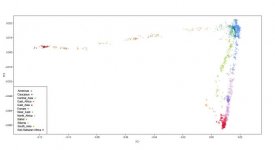On the basis of these results let me give my assumption.
I think the crucial thing in my aDNA is the influence of the Bell Beakers. Because of this basic layer in the gene pool I'am closely connected to the aDNA of especially Denmark and Western Norway and definitely not to more central parts of Europe.
First of all the analyses of David from Eurogenes. He stated:
'I may have discovered an interesting pattern in the Allentoft et al. data. It seems that during the Late Neolithic/Bronze Age, Scandinavia was populated by two somewhat different populations; one characterized by Y-Chromosome haplogroup R1b and a genome-wide genetic structure typical of present-day Northwestern Europeans, and another by Y-Chromosome haplogroup R1a and a relatively more eastern genome-wide genetic profile.'
I guess the Bell Beakers are in this case a key figure. In an archeological study from Janusz Czebreszuk
Similar but different Bell Beakers in Europe (2014), het makes regional differences in the Bell Beaker phenomenon. On basis of pottery styles he makes clear that the Bell Beakers of Northwestern Europe evolved out of the Corded Ware and was partly very assimilated with it. C.S. Coon did already talk about a Zoned Beaker (CW+BB) in his Races of Europe (1946).
I's clear that these 'Zoned Beakers' influenced the whole area around the North Sea. Wiki:
" The Beaker group in northern Jutland forms an integrated part of the western European Beaker Culture, while western Jutland provided a link between the Lower Rhine area and northern Jutland. The local fine-ware pottery of Beaker derivation reveal links with other Beaker regions in western Europe, most specifically the Veluwe group at the Lower Rhine. Concurrent introduction of metallurgy shows that some people must have crossed cultural boundaries. Danish Beakers are contemporary with the earliest Early Bronze Age (EBA) of the East Group of Bell Beakers in central Europe, and with the floruit of Beaker cultures of the West Group in western Europe. The latter comprise Veluwe and Epi-Maritime in Continental northwestern Europe and the Middle Style Beakers (Style 2) in insular western Europe. The interaction between the Beaker groups on the Veluwe Plain and in Jutland must, at least initially, have been quite intensive. All-over ornamented (AOO) and All-over-corded (AOC), and particularly Maritime style beakers are featured, although from a fairly late context and possibly rather of Epi-maritime style, equivalent to the situation in the north of the Netherlands, where Maritime ornamentation continued after it ceased in the central region of Veluwe and were succeeded c. 2300 BC by beakers of the Veluwe and Epi-Maritime style.
Clusters of Late Neolithic Beaker presence similar to northern Jutland appear as pockets or "islands" of Beaker Culture in northern Europe, such as Mecklenburg, Schleswig-Holstein, and southern Norway. In northern central Poland Beaker-like representations even occur in a contemporary EBA setting. The frequent occurrence of Beaker pottery in settlements points at a large-scaled form of social identity or cultural identity, or perhaps an ethnic identity."
Or as Rokus (on the eurogenes site) quoted Sarauw (2007):'Another point of view is put forward by Vandkilde (1996, 296; 2005, 20). According to her, the Danish metal objects, supplies, and technology originated from north-western Europe, and she sees this as an indication of particularly tight bonds between the Veluwe area at the Lower Rhine and northern Jutland. This certainly seems a very convincing interpretation.'
The Beaker culture in Jutland (2350–1950 BC) was intrusive as well as influential. Flint resources were especially distributed in Norway and western Sweden. They also maintained a separate identity. 'People of northern Jutland probably did not feel any cohesion or social identity with people elsewhere in Europe or Denmark apart from areas where tight matrimonial connections existed.'
And by the way this had even some influences of the phenotype which did pop up at this time. This can be concluded form an older work from Prof. Kooijmans
The Rhine Meuse Delta( 1974). In this work he stated that the occurrence of the planoccipital heads was an epiphenomenon of the Bell Beakers...and guess what.....my skull is indeed very planoccipital

...all coincidence or not?




